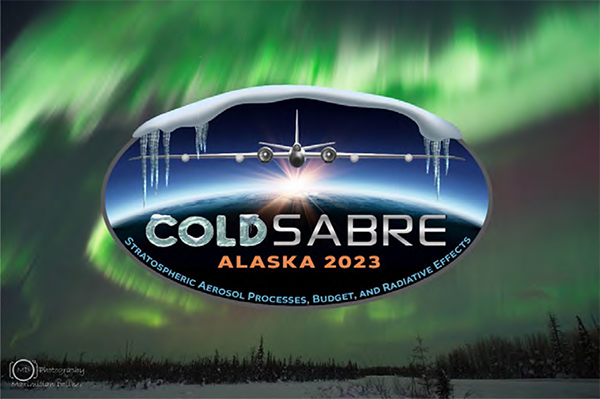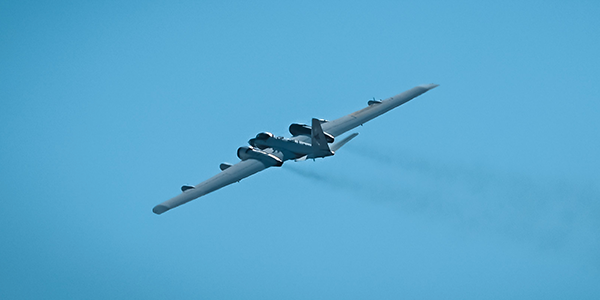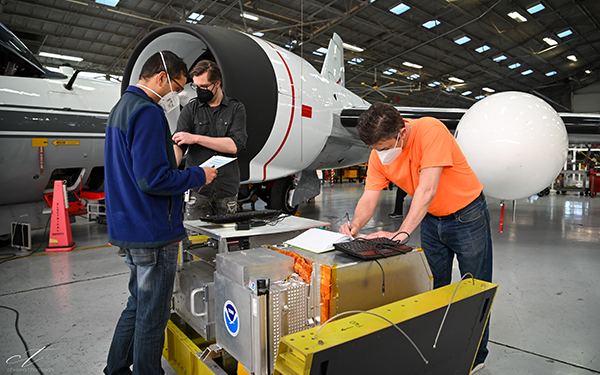A .gov website belongs to an official government organization in the United States.
A lock () or https:// means you've safely connected to the .gov website. Share sensitive information only on official, secure websites.
2 March 2023
adapted from the story by NOAA Communications

A major airborne research mission is underway in Alaska. A converted Cold War bomber packed with sensitive instruments is investigating atmospheric chemistry and aerosols over the Arctic this month in the most ambitious NOAA airborne stratospheric research mission yet.
The Stratospheric Aerosol processes, Budget and Radiative Effects (SABRE) project is one element of NOAA's growing Earth's Radiation Budget research program, an effort to provide baseline observations of the stratosphere and other elements of Earth's climate system to inform evaluations of potential future efforts to slow global warming by modifying the amount of heat captured by the atmosphere.
"Processes in the stratosphere can change climate at the Earth's surface," said Karen Rosenlof, CSL's senior scientist for climate and climate change. "Satellites give us important information, but not everything we need to know. SABRE measurements will help to assess the increasing impacts to the stratosphere through space flight or deliberate climate intervention."


Flying out of Eielson Air Force Base in Fairbanks, Alaska, a NASA WB-57 research aircraft is carrying a payload of 17 sampling instruments from NOAA, NASA, Harvard and the University of Vienna into the stratosphere, which in the Arctic extends from about 4 miles to 30 miles above the surface. The flights will gather extensive and detailed measurements of a host of trace gases, as well as physical properties of aerosols, in an undersampled region of the atmosphere.
Aerosols can reflect or absorb heat and therefore influence the climate. They also provide surfaces for important chemical reactions that control the amount of stratospheric ozone, which protects life on Earth from harmful ultraviolet solar radiation.
The WB-57 is one of the few research aircraft that can carry instruments like those deployed in SABRE well into the stratosphere.
After completing research flights in Alaska, SABRE research flights are planned for the tropics in 2024 and in the Southern Hemisphere in 2025.
In 2020, Congress directed NOAA to initiate a multi-year research program to investigate natural and human activities that might alter the reflectivity of the stratosphere and the marine boundary layer, and their potential impact on Earth's climate system. These activities include researching and assessing the potential for climate intervention approaches to influence climate warming by reflecting sunlight from the atmosphere. The deployment of climate intervention strategies large enough to offset climate change impacts could have risks and unintended consequences. Many of the processes most important for understanding climate intervention approaches – such as those that control the formation of clouds and aerosols – are among the most uncertain components of the climate system to model and understand.
NOAA is the only federal agency to date that has been funded by Congress to study climate intervention approaches. Working with government, university and industry partners, the program's overarching goal is to establish a baseline understanding of the amount of heat entering and leaving the atmosphere, identify and address knowledge gaps, and provide recommendations that will guide future research.
Some ERB projects will target pollution that already impacts the stratosphere, like ozone-depleting substances, rocket exhaust, and satellites burning up on reentry. Model simulations will help scientists understand the impacts of volcanic eruptions and climate change. But the main thrust is exploring the scientific basis for the potential effectiveness, risks and benefits of future solar geoengineering proposals. NOAA is not conducting solar geoengineering experiments in the atmosphere.
A report issued by the United Nations Environment Program (UNEP), One Atmosphere: An Independent Expert Review on Solar Radiation Modification Research and Deployment, notes that the evidence needed to make informed decisions about large-scale deployment of solar radiation modification is "simply not there."
"We have to know more about how aerosols act in the climate system to better understand the costs and benefits of climate intervention," said Rosenlof. "We are already seeing detrimental impacts on the biosphere and the economy due to climate change, and we should expect that they're only going to get worse."